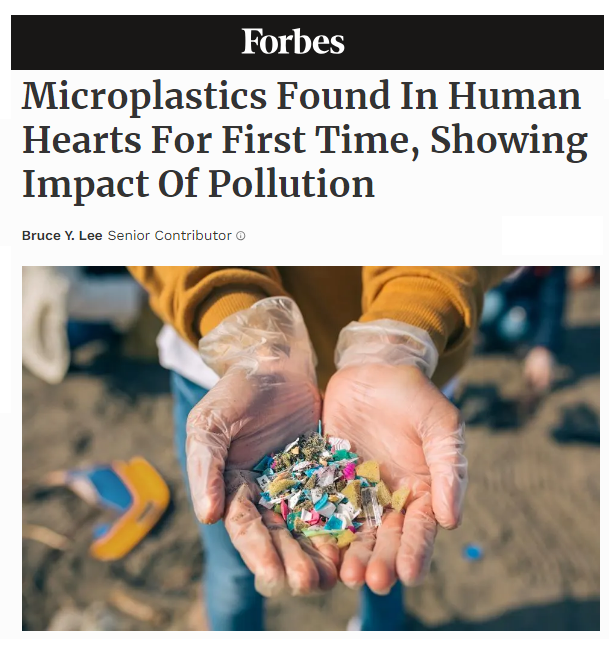Microplastics Found In Human Hearts For First Time, Showing Impact Of Pollution
Um estudo publicado na revista Environmental Science and Technology encontrou pela primeira vez microplásticos no coração de humanos submetidos a cirurgia cardíaca.
This is a case of taking a big pollution problem to heart, literally. A study published in the journal Environmental Science and Technology for the first time found microplastics in the hearts of humans undergoing cardiac surgery. Yep, while you may think that you have a heart of gold or perhaps stone, your heart may actually have microplastics in it. And in this case, life in plastic is not fantastic, regardless of what the Barbie song by Aqua says.
Microplastics are what the word seems— very small pieces of plastic that are less than 5 millimeters long—and there are concerns about what microplastics could do to you and your health. After all, “Please fill my body with pieces of plastic” is probably not what you often say.
For the study, a team from Capital Medical University, the Chinese Academy of Medical Sciences and Peking Union Medical College in Beijing used a laser direct infrared chemical imaging system and scanning electron microscopy to examine specimens collected from 15 patients who underwent cardiac surgery. Yes, they used freaking laser beams to detect the presence of microplastics in samples of tissue from the heart and surrounding structures. This included six samples of pericardia—which is the membrane that surrounds the heart as a piece of Saran Wrap might surround a knish—11 samples of the fat tissue sitting around the pericardium and six samples of the fat tissue sitting between the pericardium and the heart. They also looked at three samples of heart muscle and five samples of left atrial appendages. Microplastics were not “heartfelt” everywhere. However, the research team did find nine types of microplastics across five types of tissue with the largest piece measuring 469 μm in diameter.
They also found something bloody awful: nine types of microplastics in patients’ blood samples from both before and after the surgery. In the case, the largest piece had a diameter of 184 μm.
Now if you are wondering whether these tiny pieces of plastic simply got into patients’ hearts during the process of surgery, here are two pieces of evidence that this wasn’t simply a case of plastic surgery, so to speak. As mentioned earlier, blood samples before the surgery did contain microplastics already. Plus, the researchers found poly(methyl methacrylate), the stuff that’s typically found in plexiglass, in samples of the left atrial appendage, epicardial adipose tissue and pericardial adipose tissue. And plexiglass wasn’t something that surgeons were stuffing into people’s hearts during surgery.
It shouldn’t be super-surprising that microplastics may have made it to your heart—in a physical and not an emotional sense, that is. We are now surrounded by plastic—like a lot of plastic. Even things that may not obviously seem to have plastic, like various types of clothes, can have lots o’ plastic in them and can shed lots of these tiny pieces of plastic each day everywhere you and your clothes go. This plastic, in turn, can accumulate across many parts of your environment, including the water that you drink and the food that you eat. And think of where you tend to stick your food, water and various objects. That’s right, in your various holes and orifices, which can serve as gateways to different parts of your body. Previous studies have found microplastics in human stool, lungs and placentas, as I covered for Forbes back in 2018. But all of this may just be the tip of the plasticberg. Finding microplastics in hearts suggests that such plastic pieces can travel all over your body. In fact, you may be like a walking credit card with the amount of plastic that you already have in you.
While people may be spouting off unfounded conspiracy theories about vaccines placing microchips in people’s bodies, they don’t seem to be talking about the fact that you may be allowing more and more plastic to enter your body each and every day. Again, this is unlikely to be a positive thing, although there haven’t been nearly enough studies to determine what microplastics may do to human health. There are already some concerning findings that deserve further investigation, though. For example, a study published in the Proceedings of the National Academy of Science did find that microplastics can play havoc with oyster reproduction. This is obviously not good news if you happen to be an oyster trying to do some family planning. Whether it applies to humans remains to be seen.
There’s was also the study published in Environmental Science and Technology that I covered for Forbes back in 2019.This study exposed Daphnia magna, little crustaceans otherwise known as water fleas, to the plastic particles from the teabags. This left these the water fleas a bit ticked off, shall we say. The Daphnia magna ended up changing their swimming behaviors and development after such exposure. This could be a bit crushing if you are such as crustacean but again may or may not apply to humans.
Regardless, you’ve gotta wonder what kind of long-term health impact all of this plastic pollution around us may have. This plastic pollution problem is no longer just a micro problem, it’s become a macro problem as well permeating seemingly every ecosystem.

